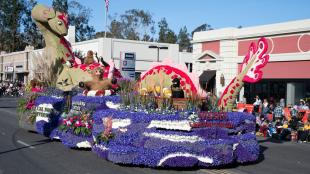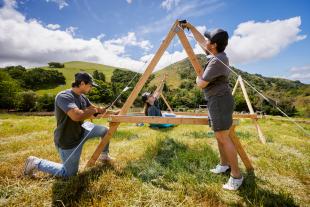Cal Poly Float Wins Director Award at 2020 Rose Parade®
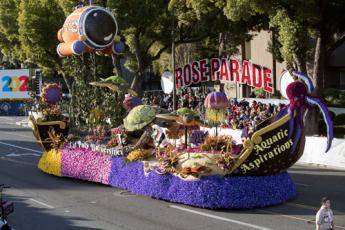
Universities’ Float ‘Aquatic Aspirations’ Recognized as California-Grown Certified for the Ninth Consecutive Year
Cal Poly universities’ playful “Aquatic Aspirations” received the Director Award for the most outstanding artistic design and use of floral and non-floral materials at the 131st Rose Parade® held New Year’s Day.
The float, which features a submarine exploring a sunken shipwreck that is also home to a colorful array of marine wildlife, was designed and built by teams of students from Cal Poly and California State Polytechnic University in Pomona. It is the seventh time in 72 appearances that a Cal Poly float has featured an ocean-related design — this year celebrating the parade’s theme, “The Power of Hope.”
“We’ve never won the Director Award before,” said Sidney Strong, an industrial engineering major who’s president of Cal Poly SLO Rose Float. “It’s both related to the design and the decorations of the float.
"I’m just so proud of our team for everything we’ve done this past year. It’s real exciting to get not only a prestigious award but one that combines multiple aspects of our program and really focuses on our success overall."
The float, which was driven in the parade by Walter Trygstad, a
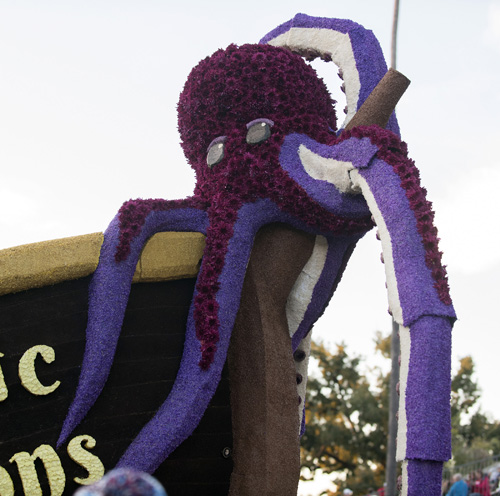
manufacturing engineering student from Davis, California, resembled a scene out of a Jacques Cousteau TV special, with animated turtles, jellyfish, swimming fish, a rocking ray and swaying kelp. While a 9-foot-long submarine rocked back and forth at the rear of the float, an octopus at the front glided 13 feet high while waving its tentacles toward the massive audience.
“This year’s Cal Poly Rose Float shows the power of Learn by Doing and multidisciplinary teamwork on a grand collegiate level,” said Cal Poly President Jeffrey D. Armstrong, who was in Pasadena to watch the parade. “‘Aquatic Aspirations’ is more than a float. To our students and an equal number of their counterparts at Cal Poly Pomona, who devote a year of their lives to this technically challenging and artistic project, it’s also a statement about the power of possibilities and of hopes and dreams realized.
“The Rose Parade captures the eyes of the world. It’s also the perfect venue to showcase this floral bouquet by a group of future industry leaders, innovators and problem solvers who through their efforts and enthusiasm are also inspiring the next generation of creatives, engineers and builders.”
“Aquatic Aspirations” is one of only six self-built entries in this year’s extravaganza that includes 39 other floats, 23 marching bands and 16 equestrian units, as well as four Tournament of Roses®-themed entrants. It was the second float and fourth overall participant at the Pasadena classic. Students said that getting a spot so early in the parade lineup may have been a first for the schools, which have been a mainstay since 1949.
Rose Parade® officials estimate that 700,000 people saw the parade in person, while 37 million Americans and an international audience of 28 million tuned in to watch it on TV.
The 18- by 55-foot entry, with its sub that rose to 30 feet, used animation to breathe life into a watery world.
“Our concept this year is really cool because we are excited to get 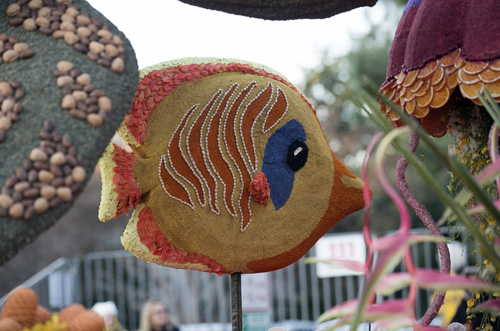 creative with some underwater creatures,” Strong said. “There’s a lot of potential for fun innovation and creating a more elegant float than we traditionally do. Cal Poly is kind of known for our fun, cartoony floats, so we’re excited to develop something a little more elegant this year.”
creative with some underwater creatures,” Strong said. “There’s a lot of potential for fun innovation and creating a more elegant float than we traditionally do. Cal Poly is kind of known for our fun, cartoony floats, so we’re excited to develop something a little more elegant this year.”
Two Cal Poly SLO students rode aboard “Aquatic Aspirations.” In addition to Trygstad, Connor Graves, a computer sciences senior from Henderson, Nevada, oversaw the float’s computerized animation elements. Both were assisted by two students from Cal Poly Pomona.
The float design was selected from more than 100 ideas submitted last spring by students, local communities, alumni and friends of the Cal Poly Rose Float program. It embodies the parade them is that no matter your aspirations, hope is a powerful guide to achieving your dreams and finding your own treasure.
Awards were announced about 6 a.m., two hours before the start of the 5½-mile parade down Colorado Boulevard.
It was the second honor in as many days. The schools were honored Dec. 31, for their continued commitment to California’s flower farmers.
It’s the ninth consecutive year the float has earned the “California Grown” designation — Cal Poly was the first honored in 2012 — from the California Cut Flower Commission, which recognizes an entry decorated with at least 85 percent of cut flowers and plant materials from the Golden State.
“Aquatic Aspirations” had almost 95 percent of cut flowers and plant materials from California — up from 91 percent last year — including a small percentage grown on the two Cal Poly campuses.
During the recent Decorations Week in Pasadena, the float was adorned with nearly 23,000 colorful blooms. The color scheme ran the gamut from blue (5,800 irises) to pink (4,800 roses and 2,100 Gerber daisies) to yellow (3,000 roses and 1,300 Gerber daisies) to purple (2,200 roses and 1,000 Crane Queen Kale blooms) and more than 2,800 multicolored fist-size protea flowers. The float was also covered with a variety of plant materials and seeds that provided a more granular texture to the floral petals. These included: chickpeas; coffee beans; cranberries; crushed popcorn kernels; golden flax seeds; seaweed; Spanish moss; split peas; and white beans.
The schools enjoy a rich history in the Tournament of Roses® Rose Parade. Among this year’s participants, the Cal Poly universities’ 72nd appearance ranks fourth highest number in parade history behind the cities of Alhambra (92) and Burbank and Sierra Madre (both 88 years). Overall, the universities have the sixth highest number of appearances; the city of Los Angeles is the most venerable with 121, followed by South Pasadena (109) and Southern California’s Alhambra, Burbank and Sierra Madre.
Cal Poly Rose Float team takes pride in its Pasadena connection. In the fall of 1948, students from San Luis Obispo and Pomona first came together, across 240 miles, to produce a float. Since then, the two schools’ entries have earned 57 awards.
In addition to the Rose Parade® trophies, the program has earned countless accolades for introducing innovations into its float designs later incorporated by professional float builders that include computer-controlled animation, hydraulic systems and cleaner emissions with propane.
The 2020 entry is no exception.
“The drive system for the float has been completely overhauled with a new digital system designed by students,” Strong said. “A new all-electric animation system has been installed to supplement the existing propane engine system.”
Cal Poly’s Learn by Doing ethos is exemplified in all facets of the float program, as students from throughout all six of the university’s colleges get hands-on experience welding, metal shaping, machining, foam carving, woodworking, painting and flower harvesting — ultimately competing against professional float builders with corporate sponsorships.

